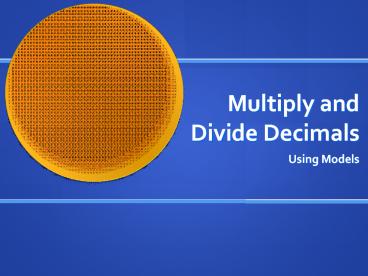Multiply and Divide Decimals - PowerPoint PPT Presentation
1 / 11
Title:
Multiply and Divide Decimals
Description:
Multiply and Divide Decimals Using Models Multiply Decimals by Building Rectangles = 1 = 0.1 = 0.01 You can model the multiplication of decimals by building a rectangle. – PowerPoint PPT presentation
Number of Views:205
Avg rating:3.0/5.0
Title: Multiply and Divide Decimals
1
Multiply and Divide Decimals
- Using Models
2
Multiply Decimals by Building Rectangles
1
0.1
0.01
You can model the multiplication of decimals by
building a rectangle.
Lets try 3.2 x 2.4
3
Multiply Decimals by Building Rectangles
3.2
- Model 3.2 as the length of your rectangle.
- Model 2.4 as the width of your rectangle.
2.4
- Use blocks to fill in the rectangle.
3.2 x 2.4 7.68
4
What Does This Method Do For Students?
- Builds an understanding of the size of numbers.
- Relates the idea of place value to something
tangible. - Creates a deeper understanding of the
multiplication algorithm. - Enforces the concept of area.
- Builds prior knowledge for the use of algebra
tiles with polynomials.
5
Your Turn
- Find 2.8 x 2.3
- Find 3.1 x 2.7
6
Work Backwards
What multiplication problem is modeled by the
blocks shown below?
2.4 x 2.4 5.76
7
What Are Some Disadvantages To Using This Model?
- Students are used to relating the blocks to
different numbers.
8
Modeling Decimal Division
The blocks are still the same!
1
0.1
0.01
We can divide decimals by separating blocks into
equal groups.
Lets divide 0.4 by 0.02
9
Divide Decimals by Grouping
20
You will have 40 hundredths pieces.
- Model 0.4
- Divide the 40 pieces into groups of 0.02
How many equal groups are there?
10
Lets Try Another
4
11
Drawing Conclusions
- Find 36 divided by 12. How does this problem and
its quotient compare to 3.6 divided by 1.2? - Could you use base-ten pieces to find the
quotient of 2.3 divided by 0.3? Justify your
answer.































